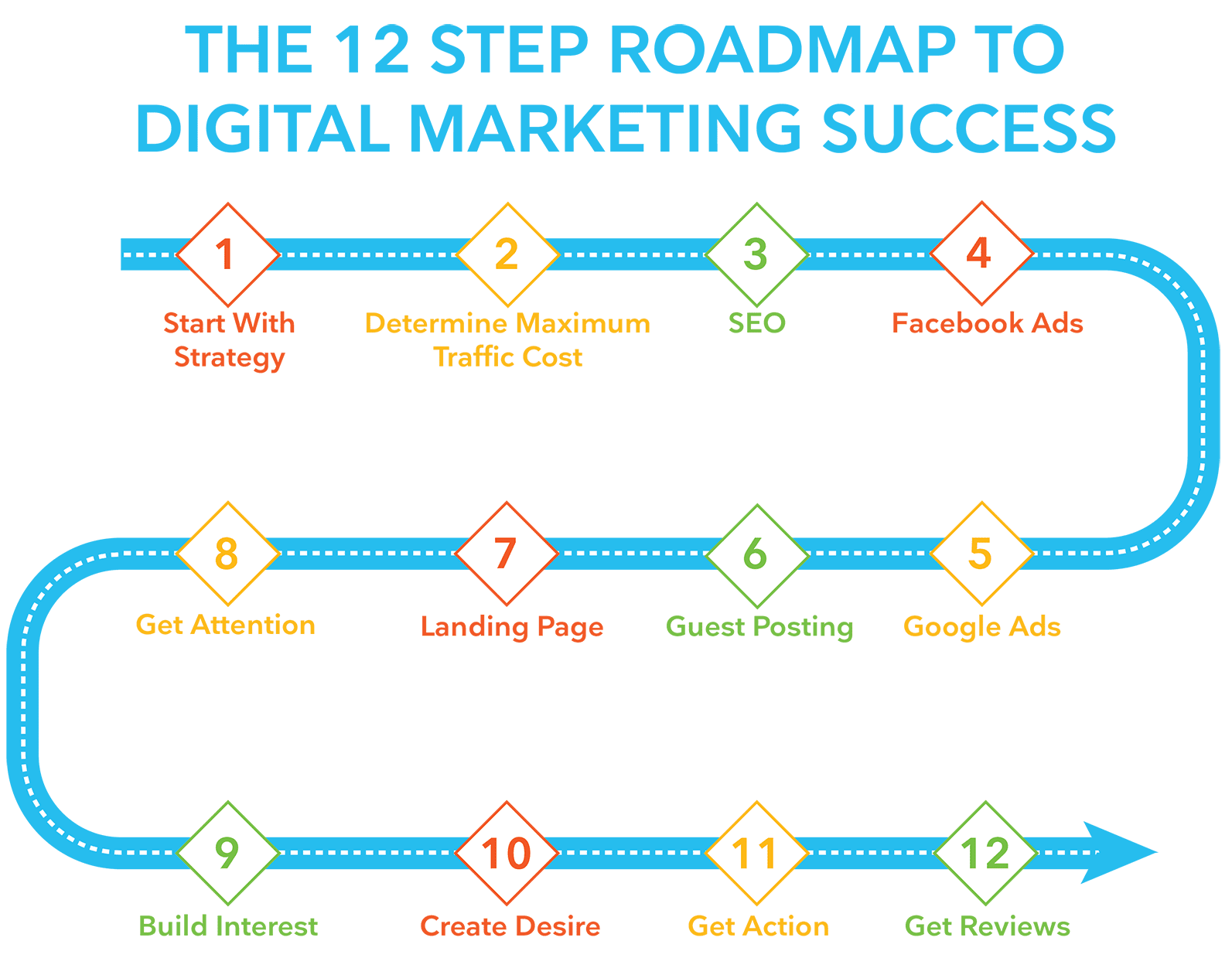Sometimes it might feel like you're travelling the Digital Marketing Transformation road without a map. But what even is a digital marketing roadmap? How do you build one? What is going on? All these questions are answered, and more, in this article.

With 47% of organisations having no digital transformation at all, and 59% expressing concern that it may be too late for them to begin implementing digital transformation measures, it can seem like a daunting task.
But don't worry. Consider us your Google Maps of digital marketing transformation. Or Waze, if you're that kind of person. Or City Mapper, if you're a metropolitan young professional. Or even an A to Z, if you're a pen-and-paper-not-even-on-Facebook-yet marketer. We accept all here.
Most teams go through their day-to-day without a clear idea of what digital activities can drive success for their business. Many companies who define their goals, and follow a digital roadmap can often meet or exceed their goals.
In fact, analysts expect investments in digital transformation to reach $2.3T globally by 2023. That's trillion with a T. The benefits of digital transformation can include better supply chain management, improved ability to meet customer needs, secure data management, and even stronger profitability.
However, marketing technology is a crowded space. The current 2022 Martech Map categorises a whopping 9,932 martech solutions, mapped into 49 categories. Our most recent report at LXA estimated that the martech industry in North America and the UK was worth $149.7bn in 2021. We believe these results are typical of key global markets, suggesting a worldwide market figure of a whopping $344.8bn.
In a recent interview with us, Scott Brinker commented on how much has changed since his last edition:
We continue to see rapid growth within the marketing technology industry. I haven’t published a 2021 landscape yet, but we’ve been researching it. I’m quite confident in saying it will contain more than 10,000 vendors if we published it today.
I think the way I would describe it is for the past five to 10 years pretty much every company has been talking about digital transformation.
I've consulted with a number of them, and they all have these five to 10-year plans of how they’re going to digitally transform and everything always took longer than anyone anticipated.
So, let's jump into what you're here for. Your top FAQs answered.
Question One: What is Digital Transformation?
Digital transformation is the process of using digital technologies to create new or improve existing, processes, customer experiences, and culture within a company. This is done in order to meet changing business and market requirements.
Digital transformation examples can include mobile applications, constant connectivity, instant loan approvals, virtual try-on, buy online and pick up in-store, etc. etc.
So...not exactly easy to define, as you can see. It's gonna look different for every company. Might not be the best idea to try shoehorning in a virtual try-on for your accounting business. This means it'll be hard to pinpoint a definition that applies to all. However, we can have a good old go.
Digital transformation can be defined in general terms as the integration of digital technology in all aspects of a business, resulting in bug changes to how the company operates, and how it delivers value to customers.
As a result, there will be a cultural change that requires organisations to continually challenge the status quo, experiment often, and get used to failure. In a good way, promise. This can mean moving away from long-standing business processes that companies were built upon, in order to try out new practices that are still being defined.
In an article, McKinsey defined digital transformation as "an effort to enable existing business models by integrating advanced technologies". So, this means digital transformation allows digital technologies to be integrated into already existing business models, changing the way you operate and deliver your product.
Harvard, similarly, defines digital transformation as the integration of digital technology into all areas of business and stresses the cultural change aspect. It requires organisations to continually challenge the status quo and experiment.
Question Two: What is a Digital Transformation Roadmap?
A digital transformation roadmap is a map which moves your organisation from point A i.e. using your current digital processes, to point B, which is using your new digital processes. Just like a real road trip. But just like a road trip, you need to map out how you'll arrive at your destination.

So, the roadmap is the foundation which guides all your digital marketing efforts from start to finish. The digital marketing roadmap begins with a strategy and is supported by a series of tactics to help achieve your goals.
Question Three: What are the Four Main Areas of Digital Transformation?
According to Microsoft, the four key areas of Digital Transformation are:
- Empowering employees. As change managers know, employee motivation and skills are critical for organisational transformations – including digital transformations – to succeed.
- Engaging customers.
- Optimising operations.
- Services and products.
Question Four: How Do You Build a Digital Strategy Roadmap?
Key aspects of digital transformation success include:
- Regular engagement between teams, weekly updates, quarterly strategic check-ins, demos, and retrospectives
- Clear, aligned ways of working
- Alignment on short-, mid-and long-term goals with a client
- The roadmap is defined and shared between the client and the company
- Goals & roadmaps are shared with teams and on the client-side
- Client scoreboards are shared with key performance metrics & goals
So, what steps can you take to build your strategy?
Step One: Identify your Objectives. A strategy should provide a clear understanding of what your objectives are, and what steps are required. Remember, each organisation's objectives will vary.
Step Two: Focus on Customer Needs. A digital transformation process is all about leveraging digital tools to increase customer value, so you need to take your customers' needs into account at all points.
Step Three: Establish new Processes. For some companies, digital transformation will require a complete overhaul of processes. So, it's vital to rally employees together to ensure everyone understands the changes, who is accountable for what, and which systems will be implemented to support the team.
Step Four: Choose your Technology Wisely. You don't need every piece of technology under the sun to succeed. Choose the technology that will support the process you're optimising.
Step Five: Restructure to Accommodate Change. "Presently, dwindling numbers of organizations operate using highly hierarchical models, in which decisions are taken in a traditional top-down manner," Inside magazine has noted.
Step Six: Execute your Plan. Now it's time to put the plan in motion. Rather than trying to do everything, everywhere, all at once, slow down. Instead, take a step back and work in iterations.
Step Seven: Allow Space for Agility. A survey by McKinsey found that less than 30% of companies are successful in implementing digital transformation. And, only 16% of respondents said their digital transformation plan successfully improved performance and sustained long-term changes.
Question Five: What is an Example of Digital Transformation?
Some examples of digital transformation include implementing tangible, customer-centric tools like mobile applications or websites that improve the customer journey. Some others may involve machine learning or AI algorithms that transform a traditional business into a digital business.
There is an emergence of businesses recently that are built on digital transformation. Take Carvana for example. They started with the ability to buy a car completely online, from start to finish, delivering the car to your home and giving you a trial period to test it out. But they still found ways to innovate further, with Carvana vending machines — essentially unmanned towers of cars where consumers can pick a car and drive away with it.
Question Six: Why Do Digital Transformations Fail?
Though the aim of digital transformation is the make everything easier and quicker, the journey to get there can be quite the opposite.
A 2020 study by Boston Consulting Group found that a whopping 70% of digital transformation projects fall short of their goals, even when the leadership is aligned. So, let's have a look at some common reasons why a digital transformation strategy can fall flat.
Number One: Not Having the Right Data (or the right data in the right place)
The pandemic has (understandably) affected how businesses do, well, business. It has forced digitisation on many companies and pushed them towards accelerating their digital initiatives. So, in order to survive in this new digital environment and economy, companies must capitalise on their data growth, and deliver new solutions.
This means making sure the right data is in the right place becomes vital, as it tends to be distributed across clouds, devices, and accounts.
Number Two: You're Working with Poor Onboarding Processes
Inaccurate and poor onboarding processes and a lack of purpose-built systems for onboarding are the most common underlying reasons for failed digital transformation projects.
Number Three: Implementing New Tech onto Bad Systems, and Utilising an Outdated Tech Stack
Digital transformation can often disappoint. A combination of layering shiny new tools and broken processes and reluctant teams can often lead to less-than-desirable results. So, instead, you should develop integrated strategies, with clearly defined goals and processes. Then, digital innovations should enable these efforts.
Number Four: Employees are Underprepared, Resistant to Change, and Lack the Proper Skills
Digital transformation is all about change. But what if your team isn't? It can be difficult to get people on board. Not only does leadership need to be aligned, but the whole organisation can need a cultural shift.
Number Five: You're Failing to Set Clear End-User Experience Goals
The chance of failure can be increased when there are many legacy applications that need to be migrated to the cloud. Some enterprises fail to set clear goals in terms of end-user experience, and don't properly benchmark end-user experience before, during, and after these migrations. Not having clear goals to achieve in terms of end-user experience, and ways to measure it accurately can lead to failure.
Number Six: You're Mistaking Digitisation for Digitalisation
Companies can often fail at digital transformation by purely not understanding it. This can look like being unable to differentiate between digitisation and digitalisation. Digitisation looks like converting products or processes to a digital form. On the other hand, digitisation looks like making the most out of the opportunities of digitised products and processes.
So, did you find your way on the digital marketing transformation roadmap? I've even drawn an X on the comically oversized paper map you've managed to find in 2022. Think of this whole process as a treasure hunt, with a far more lucrative reward than gold doubloons.
